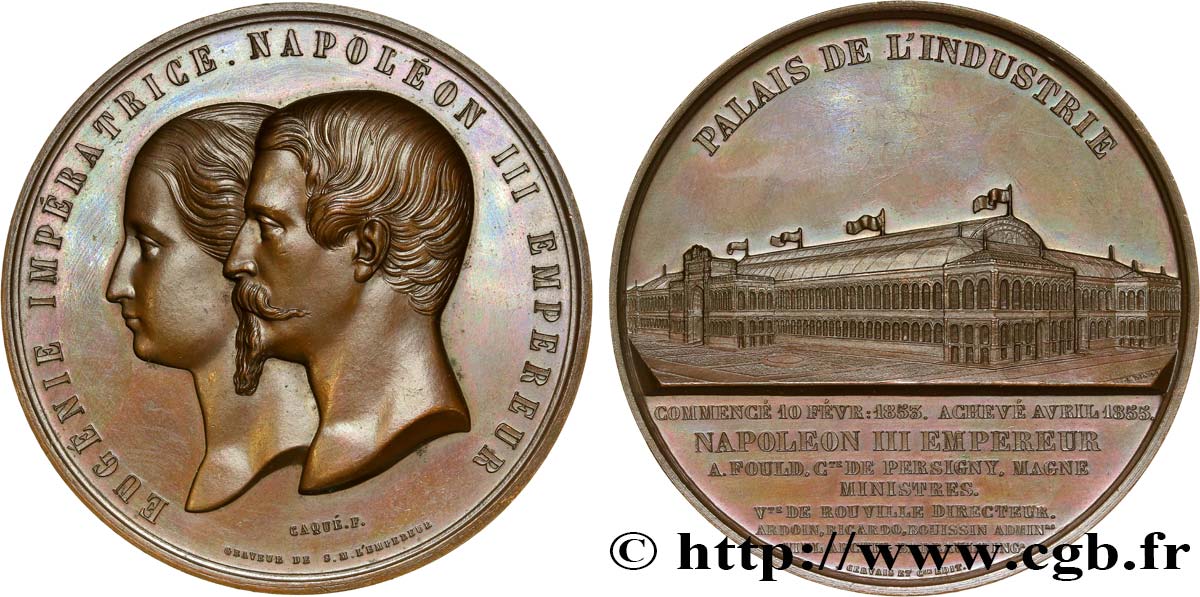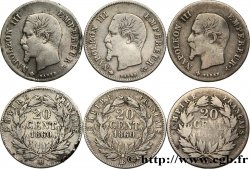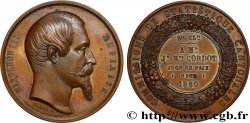fme_367858 - SECOND EMPIRE Médaille du palais de l’Industrie, vue nord-ouest
Not available.
Item sold on our e-shop (2018)
Price : 350.00 €
Item sold on our e-shop (2018)
Price : 350.00 €
Type : Médaille du palais de l’Industrie, vue nord-ouest
Date: 1855
Mint name / Town : 75 - Paris
Metal : copper
Diameter : 68,5 mm
Orientation dies : 12 h.
Engraver CAQUÉ Armand Auguste (1795-1881) / GERVAIS ET CIE ÉDIT.
Weight : 147 g.
Edge : lisse + main CUIVRE
Puncheon : main indicatrice (1845-1860) et CUIVRE
Coments on the condition:
Superbe médaille particulièrement bien frappée et conservée avec magnifique patine
Obverse
Obverse legend : EUGÉNIE IMPÉRATRICE . NAPOLÉON III EMPEREUR.
Obverse description : Têtes d’Eugénie et de Napoléon III à gauche.
Reverse
Reverse legend : COMMENCÉ FÉV 1853. ACHEVÉ AVRIL 1855 / NAPOLÉON III EMPEREUR / A. FOULD, CTE DE PERSIGNY, MAGNE / MINISTRES / VTE DE ROUVILLE DIRECTEUR / ARDOIN, RICARDO, BOUISSIN, ADMINRE /
VIEL ARCH. BARRAULT INGR / GERVAIS ET C. EDIT..
Commentary
Cette médaille se rapproche des médaille de même type de 37 mm en zinc ou en cuivre (cf. fme_367377 et fme_370568) mais avec une diamètre bien plus important et une légende légèrement différente à l’exergue.
Le Palais de l'Industrie et des Beaux-arts, ou plus communément Palais de l'Industrie, est un édifice construit pour l'Exposition universelle de 1855 sur les Champs-Élysées à Paris. Il est l'œuvre de l'architecte Victor Viel et de l'ingénieur Alexis Barrault. Il est détruit à partir de 1896 pour laisser place au Petit Palais et au Grand Palais.
Inauguré le 15 mai 1855 par Louis-Napoléon Bonaparte, récemment devenu l'empereur Napoléon III, il fut l'emblème de la première Exposition universelle française. Cette Exposition, qui attira plus de cinq millions de visiteurs, fut la réponse du chef de l'État français au succès de l'Exposition universelle de 1851 de Londres, célébrée notamment pour l'audace et la nouveauté de son Crystal Palace..
This medal is similar to the 37 mm medals of the same type in zinc or copper (see fme_367377 and fme_370568) but with a much larger diameter and a slightly different legend in the exergue. The Palace of Industry and Fine Arts, or more commonly the Palace of Industry, is a building constructed for the 1855 World's Fair on the Champs-Élysées in Paris. It is the work of the architect Victor Viel and the engineer Alexis Barrault. It was demolished in 1896 to make way for the Petit Palais and the Grand Palais. Inaugurated on May 15, 1855 by Louis-Napoléon Bonaparte, who had recently become Emperor Napoleon III, it was the emblem of the first French World's Fair. This Exhibition, which attracted more than five million visitors, was the response of the French head of state to the success of the 1851 Universal Exhibition in London, celebrated in particular for the audacity and novelty of its Crystal Palace.
Le Palais de l'Industrie et des Beaux-arts, ou plus communément Palais de l'Industrie, est un édifice construit pour l'Exposition universelle de 1855 sur les Champs-Élysées à Paris. Il est l'œuvre de l'architecte Victor Viel et de l'ingénieur Alexis Barrault. Il est détruit à partir de 1896 pour laisser place au Petit Palais et au Grand Palais.
Inauguré le 15 mai 1855 par Louis-Napoléon Bonaparte, récemment devenu l'empereur Napoléon III, il fut l'emblème de la première Exposition universelle française. Cette Exposition, qui attira plus de cinq millions de visiteurs, fut la réponse du chef de l'État français au succès de l'Exposition universelle de 1851 de Londres, célébrée notamment pour l'audace et la nouveauté de son Crystal Palace..
This medal is similar to the 37 mm medals of the same type in zinc or copper (see fme_367377 and fme_370568) but with a much larger diameter and a slightly different legend in the exergue. The Palace of Industry and Fine Arts, or more commonly the Palace of Industry, is a building constructed for the 1855 World's Fair on the Champs-Élysées in Paris. It is the work of the architect Victor Viel and the engineer Alexis Barrault. It was demolished in 1896 to make way for the Petit Palais and the Grand Palais. Inaugurated on May 15, 1855 by Louis-Napoléon Bonaparte, who had recently become Emperor Napoleon III, it was the emblem of the first French World's Fair. This Exhibition, which attracted more than five million visitors, was the response of the French head of state to the success of the 1851 Universal Exhibition in London, celebrated in particular for the audacity and novelty of its Crystal Palace.








 Report a mistake
Report a mistake Print the page
Print the page Share my selection
Share my selection Ask a question
Ask a question Consign / sell
Consign / sell
 Full data
Full data















